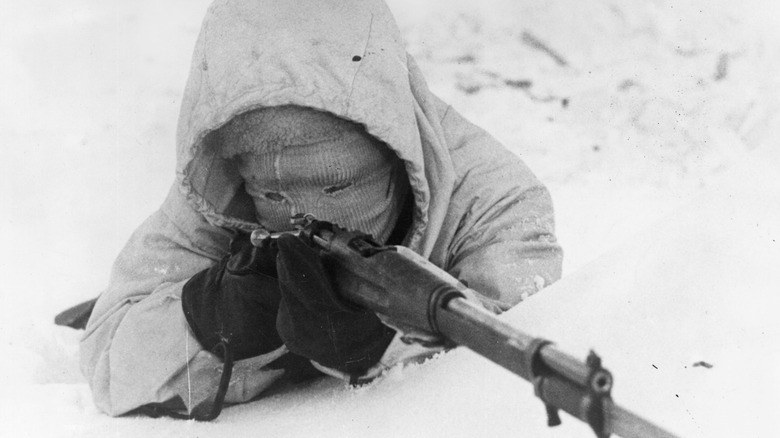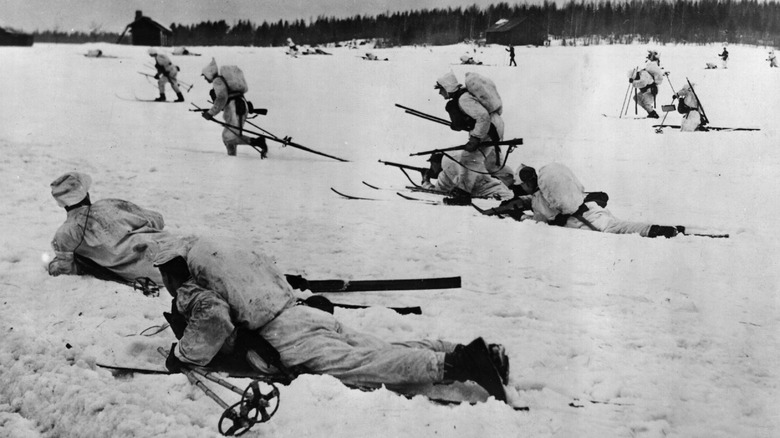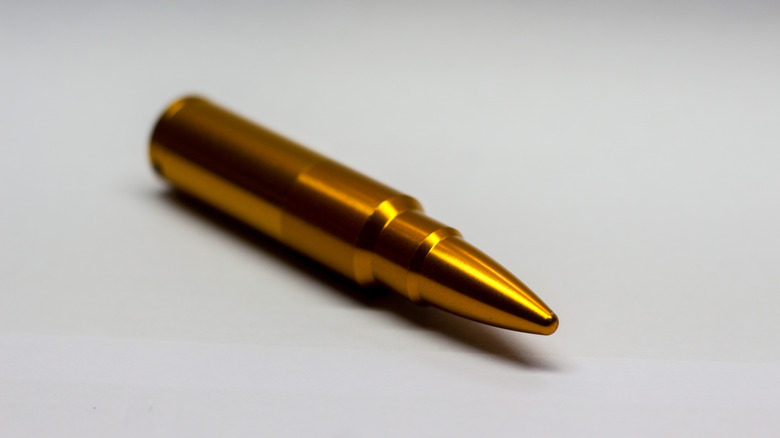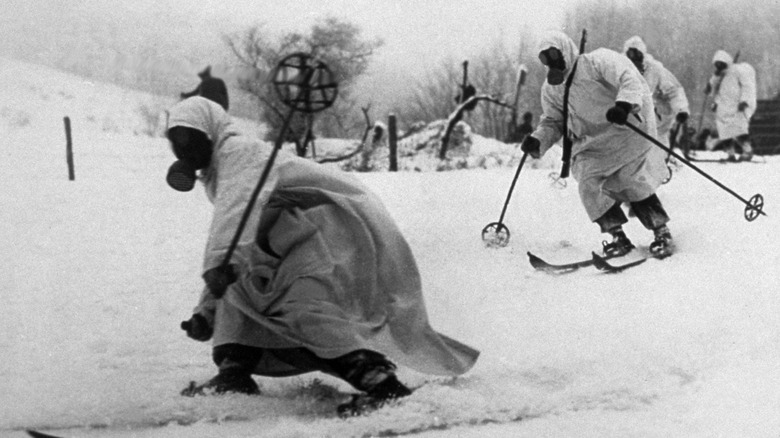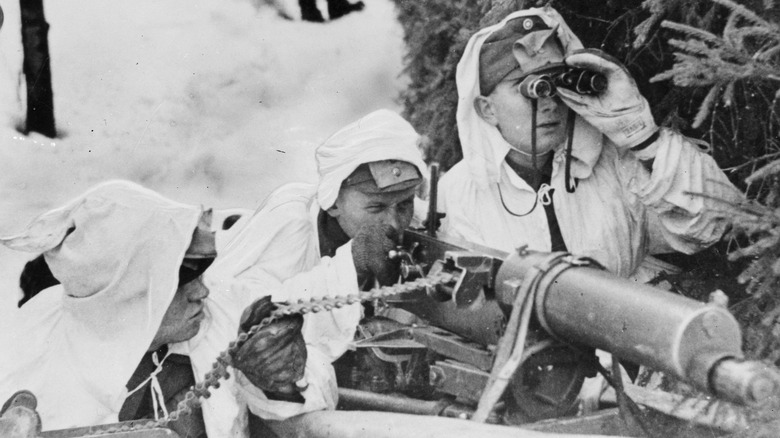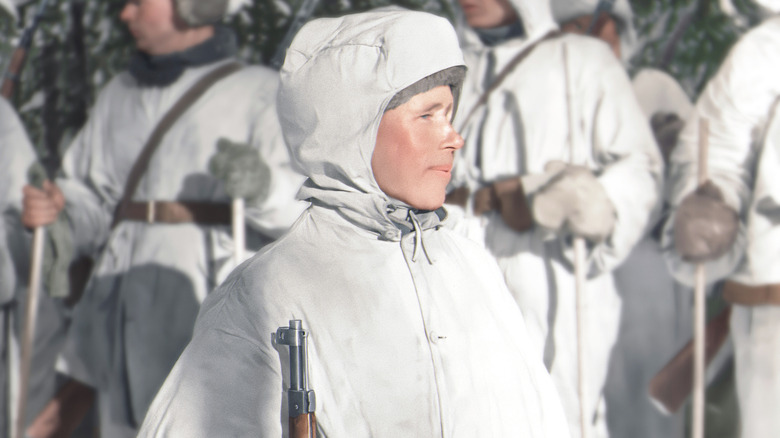The White Death: The Truth About The Greatest Sniper You've Never Heard Of
When a half-million Soviets invaded Finland on November 30, 1939, they believed that taking the country would be an easy task and the perfect 60th birthday present for their leader, Josef Stalin. According to Radio Free Europe Radio Liberty, although Finland declared itself neutral during WWII, the USSR feared the Nazis could attack them through Finland as the country refused to push its borders away from Leningrad (now St. Petersburg). The invasion became known as the "Winter War," which lasted for several months and was a surprising challenge for the USSR.
The USSR had 6,000 tanks and 3,000 airplanes, while Finland had just a few tanks and only 100 planes, All That's Interesting reports. However, the USSR underestimated the tiny nation. When the Soviets invaded Finland, their soldiers wore dark uniforms, making them easy targets for the sharpshooters. The Finnish soldiers wore white camouflage, which was more suitable for hiding in the snow than the enemies' black uniforms.
The invasion caused a stir in the media, as Finland was a neutral country. When images of airplanes dropping bombs on Finland reached the media, Vyacheslav Molotov, the Soviet Foreign Minister, claimed they were dropping food and supplies. The Soviets called the bombs "drink to go with the food."
Despite Soviet power, the Finnish had a weapon the Red Army could never have: Simo Häyhä, the "White Death."
Simo Häyhä killed over 500 people
Simo Häyhä is believed to have killed 542 Soviet troops during the Winter War and is considered the deadliest sniper in history, per Forces. Years later, when someone asked if he regretted killing those people, he said, "I only did what I was told to do, as well as I could," reported Radio Free Europe Radio Liberty. Häyhä used an old-fashioned rifle, a humble weapon compared to the Soviet guns.
According to Forces, Häyhä owned an M/28-30 rifle many years before the war, and he enjoyed its reliability. Incredibly, the rifle did not even have a telescopic sight. He was also aware that, with temperatures dipping to -20 degrees during the winter in Finland, it could affect the gun, so he was careful with the maintenance. His highest kill count for one day, as History Extra reports, was 25.
Surprisingly, Häyhä was not an intimidating person. He was a 5-foot-tall farmer who was described as mild-mannered and unassuming and only served the army during his mandatory year of military service (via Ideapod). His hobbies included snow-skiing, hunting, and shooting, which became valuable skills during the war.
Simo Häyhä was a talented hunter
Simo Häyhä claimed he was never scared and treated his job like hunting. His main concern was to make sure the weapon was stable, and that his feelings would not affect his work. The soldier had no problems being alone during the war and spent hours preparing his shooting positions and making sure the enemies could not track his steps (via Forces).
While growing up, Häyhä learned from his father to stay nearly 150 meters (almost 500 feet) from his target and analyze how rain, wind, and snow would affect his shot. During the night, he would visit his fire positions and prepare the location for the next day, and he would often hide behind overhanging branches. Häyhä spent most of his life going on hunting trips into the woods, which gave him a later advantage during the Winter War.
The sniper developed techniques to hide his location and used sounds, smoke, and artillery fire to cover his movements, per History Extra. Häyhä had an impressive memory and paid attention to the landscape shape, shadows, and tree trunks. If anything changed, it could be a sign that the Soviets had been there.
There was a rumor that Häyhä used to hide in trees to shoot his enemies, but he laughed that off. The sniper said that climbing a tree would limit his moves, and he would not have an escape route if enemies caught him.
The White Death earns his name
It's easy to see how Simo Häyhä might have inspired terror in the hearts of Russian soldiers. He made himself so invisible, so undetectable, that when the Red Army marched through the forests and fields of Finland, it must have seemed like the very snow was on the attack. Häyhä's stealth tactics, absolute patience, and utter meticulousness were an enormous part of his success in the field, and why he got his nickname, "The White Death."
Ideapod and War History Online provide details. When setting out for the day, always solo, Häyhä wore his signature all-white winter camouflage. He didn't just settle in for an hour or two, but from before dawn until after sunset, and used smoke and artillery fire to cover himself if he had to change position, as History Extra says. He scoped these positions ahead of time, did after-the-fact assessments, and took a full day's worth of ammunition and food with him in the meantime. Because detection is a sniper's worst enemy, he also built up snow around him to provide extra camouflage and prevent light from catching on his rifle. He would also place his mouth on nearby snow to prevent his breath from fuming in the cold air and pour water in the snow in front of his gun to prevent the snow from bursting when he fired rounds.
In short time, the Russians began referring to Finland's invisible, snow-shrouded killer as "The White Death."
Wounded and nearly left for dead
Simo Häyhä was a supernaturally impressive soldier, and the Soviets rightfully feared him. On more than one occasion they tried to take Häyhä out using counter snipers, even whole artillery bombardments, but to no avail. One time, as History Extra describes, the Soviets started shelling the location where they thought Häyhä's shots had come from, but Häyhä made it out completely unscathed. This happened after Häyhä killed an enemy combatant with a single shot, which when hunting is always preferable so that prey doesn't run away. Another time, an artillery shell managed to land near Häyhä. While it didn't hit him directly, it did tear open the back of his jacket. Häyhä himself only got "a minor scratch to his back."
Häyhä's luck and talent didn't make him invincible, however, and he was eventually seriously wounded. On March 6, 1940, the 98th day of the Winter War and a week before the war would end, Häyhä was hit in the jaw by an explosive bullet. He was taken for dead, and as War History Online states, was chucked on a pile of bodies. A fellow soldier saw his leg twitching, and he was taken to a hospital. It was there, in a coma, that Häyhä recovered through the end of the Winter War and the armistice between Finland and Russia.
White for purity and innocence
Simo Häyhä woke up from his coma with his left upper jaw, lower jaw, and cheek destroyed, per Ideapod. He spent 14 months in the hospital, underwent 26 facial surgeries, and still lived with facial pain and scarring for the rest of his life, as History Extra explains. His speech never fully recovered. Even with these injuries, Häyhä wanted to participate in the second war against the Russians, the Continuation War (1941 to 1944), but was excused because of his injuries.
Häyhä retired to a farm in Karelia in southeast Finland. He never married or had children, and rarely interacted with society. He received death threats from the public for his role in the war, and simply replied, "I did what I was told to do, as well as I could. There would be no Finland unless everyone else had done the same." A friend once said of him, "Simo spoke more with animals in the forest than with other people."
In the decades following World War II, Häyhä evolved into a legend and national icon. As a 2020 study in the Finnish International Journal of Heritage Studies states (on Research Gate), he been woven into the fabric and myths of modern Finland. He's inspired metal songs, erotica novels, manga, and both his name and camouflage — white — have come to represent purity and innocence.
Häyhä died alone in 2002 at the age of 96.
